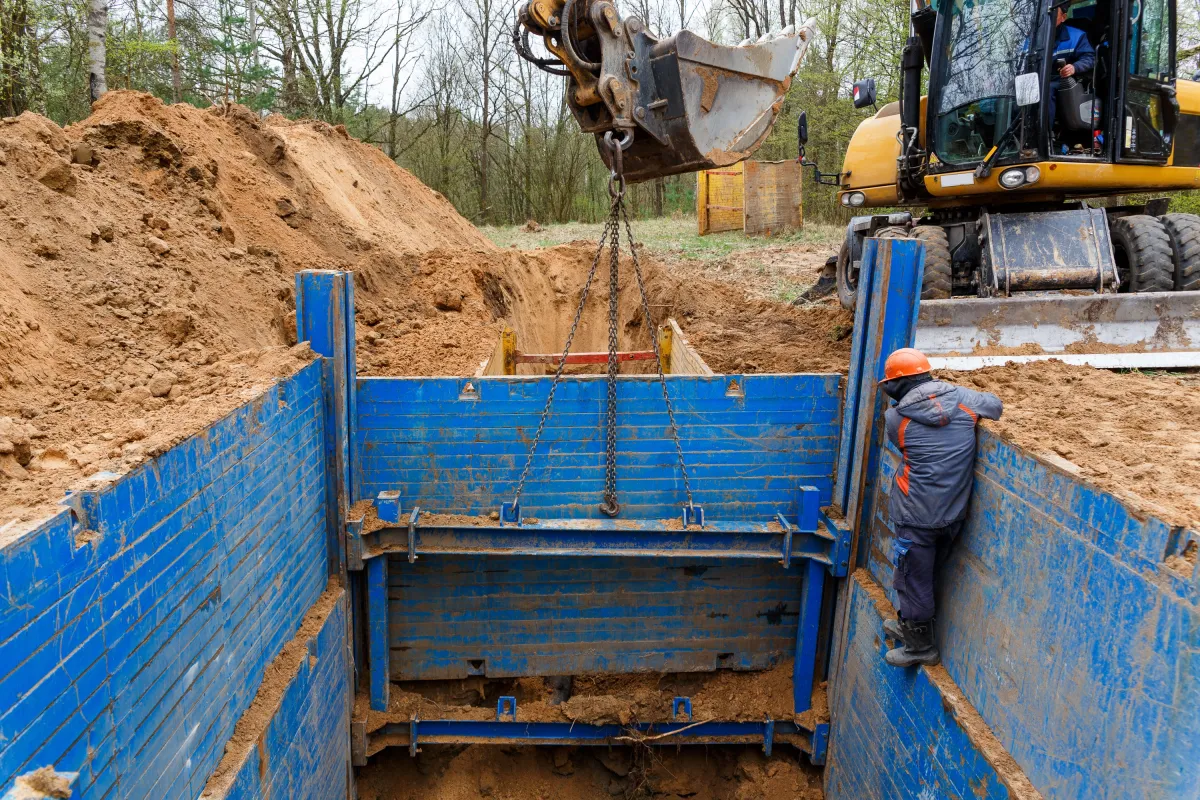Trench Box Excavation Services Near Wisconsin
Why Trench Box Excavation Keeps Crews Safer and Projects Moving
Digging deep trenches comes with real risk—especially when the walls aren’t supported. Trench box excavation is designed to prevent cave-ins and protect crews working below grade. Whether you're installing new utility lines or repairing existing infrastructure, trench boxes create a safer space to get the job done.
Not every site has the same conditions. Wet soil, nearby traffic, and equipment movement all impact how stable a trench stays over time. Trench boxes add a layer of security that gives everyone peace of mind—especially when projects run long or conditions change suddenly.
This page will walk you through where trench boxes are most useful, how crews use them effectively, and what separates a good excavation team from a careless one. If your job involves deep digging, it's worth knowing exactly how this safety tool fits into the bigger picture.
How Can We Help?

Betts Utility Contractors LLC is Committed to superior quality and results!

AVOID COSTLY MISTAKES:
Do NOT hire an excavating contractor without first reading our free guide:
The ULTIMATE Excavation & Septic "Success Guide."


The Role Trench Boxes Play in Deep Excavation
Trench boxes act as physical barriers that prevent soil from collapsing into open trenches while work is being done. They allow workers to enter and exit safely, giving access to the trench without worrying about the ground shifting. For projects involving pipelines, conduit installs, or underground repairs, they’re often a necessity—not a preference.
Soil stability can change quickly based on moisture, surrounding vibrations, or even prior excavation work. That’s why crews must evaluate each site before using a trench box—it’s not one-size-fits-all. The depth of the trench, type of soil, and length of the job all influence how trench boxes should be placed and removed.
When Trench Boxes Should Be on Site
Any time workers are entering a trench that’s deeper than a few feet, trench boxes should be part of the setup. They offer fast protection and can be installed with minimal disruption to the workflow.
Common Situations That Call for Trench Boxes
New Utility Line Installation
Trench boxes allow safe access to dig and place pipes, cables, or conduit—especially in deeper runs where collapse risk increases.
Repairs on Aging Underground Systems
Older lines often require more digging to reach, making soil conditions less predictable. Trench boxes give crews the space they need to work without worry.
Extended Projects with Repeated Access
When crews need to get into the trench repeatedly over days or weeks, trench boxes offer consistent safety without constant rework.
Who Uses Trench Box Excavation the Most
City and Utility Crews
Public works projects often involve deep trenches for sewer, water, or gas lines. Trench boxes protect workers while minimizing site disruption.
Commercial Contractors and Site Prep Teams
Commercial developments rely on trench boxes during stormwater, plumbing, and electrical installs. They keep the schedule moving while maintaining a safe environment.
Emergency Utility Repair Teams
Fast-response teams use trench boxes when responding to utility failures that require deep digging. The boxes let them work quickly without compromising safety.
See Our Excavation & Hydrovac

✔️ Utilities Trenching
✔️ Trenching
✔️ Hydro Excavation
✔️ Daylighting/Potholing Services
Quality Services Launched FAST!

✔️ Hydrovac Services
✔️ Remote Hose Excavation
✔️ Utility Pole Hole Digging
✔️ Catch Basin Cleaning
What Are You Waiting For?
Choosing a Team That Knows How to Use Trench Boxes Right
Why Setup and Removal Matter More Than You Think
Using trench boxes isn’t just about dropping steel into a hole—it’s about how they’re handled before, during, and after the dig. Crews must know how to lower them safely, secure them properly, and remove them without disturbing surrounding soil. These steps can either protect the site—or cause problems if done wrong.
How Smart Crews Keep Things Moving Safely
The best trench box crews balance safety with speed. They coordinate with other teams on-site, maintain a clean work zone, and follow consistent procedures with each install. That attention to detail prevents slowdowns and keeps everyone working confidently.
Inexperience Can Turn Risk Into Reality
A poorly installed trench box is no better than no box at all. When crews rush, skip steps, or ignore changes in soil conditions, they put everyone at risk.
What to Watch for in a Reliable Crew
They Take Time to Set It Up Right
Experienced crews don’t rush placement or assume the soil will hold. They level the trench, set the box properly, and confirm that everything is stable before anyone goes in. This careful approach ensures safety from the very first step.
They Keep the Site Clean and Organized
A tidy trench area says a lot about the crew’s habits. If they’re careful with their setup, they’re likely careful with the rest of the job, too. Clean sites also make it easier to spot hazards and reduce the chance of accidents.
They Follow a Routine That Doesn’t Change Under Pressure
Tight schedules don’t lead to shortcuts. The right team knows that safety routines aren’t flexible—no matter how fast the project needs to move. Even in time-sensitive situations, they stick to what works.
Matching the Right Crew to the Job
Urban Utility and Infrastructure Projects
Crews who work in cities understand how to manage space and traffic around deep trench work. They plan carefully and protect both workers and the public. Their experience helps prevent costly delays and maintain a smooth jobsite flow.
Private Commercial Construction Sites
Commercial jobs require coordination with other trades and lots of moving parts. The best trench box crews stay out of the way while keeping their own operation efficient and safe. They work with awareness of site demands, not just their own tasks.
After-Hours or Emergency Digging
Late-night digs or emergency utility fixes require quick but careful work. Crews trained in these conditions bring the right mindset and setup to keep things stable under pressure. Their ability to adapt fast without skipping steps makes them essential when time is tight.
Hours: 8-5 M-F
Extended hours by appointment only.
Address: Sparta, WI 54656
